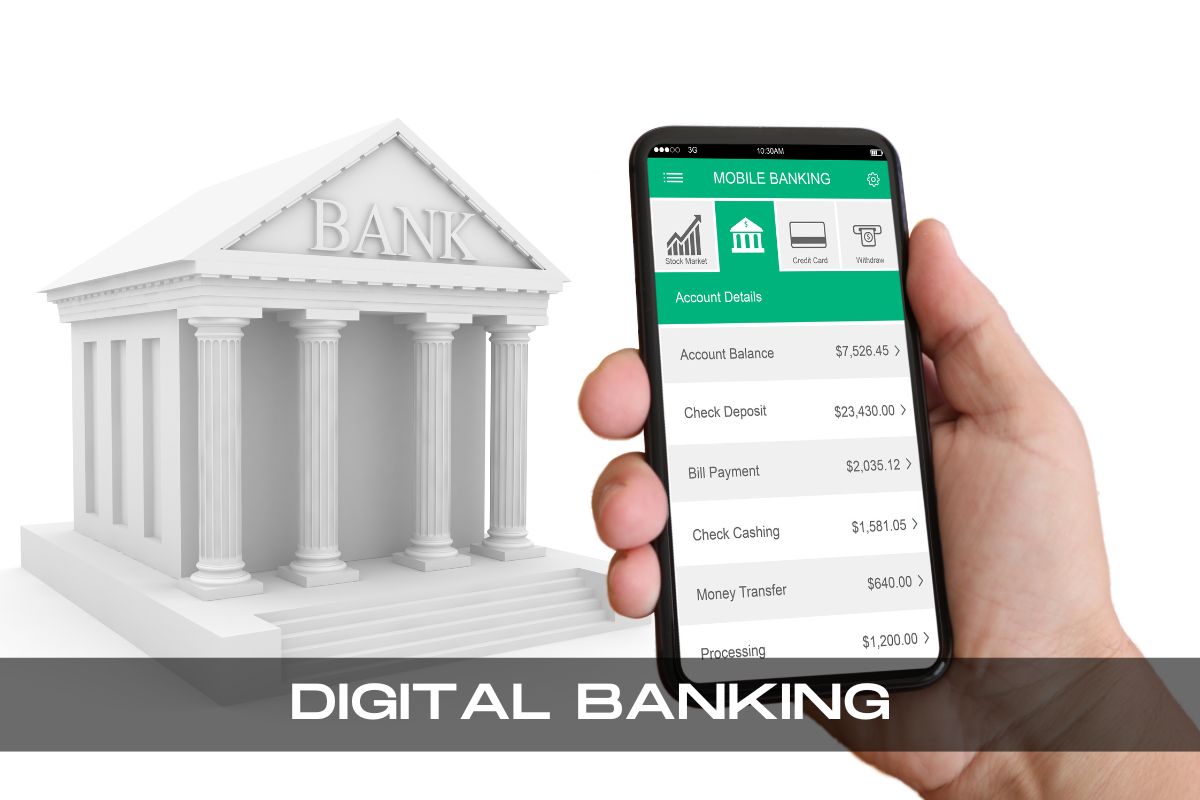Discover the future of banking with our expert insights on digital transformation in the financial industry. Learn about the latest technology and strategies for modernizing banking services.
Table of Contents
Introduction
Digital banking refers to the use of digital technology to provide financial services to customers. This includes online banking, mobile banking, and the use of digital platforms to access financial products and services.
The digital banking revolution has greatly impacted the financial services industry, making it more convenient, efficient, and secure for customers.
As technology continues to advance, the future of digital banking looks to be even more integrated and innovative, with the potential to revolutionize the way we access and use financial services. In this blog post, we will explore the benefits of digital banking, the future of the industry, and the challenges and obstacles that may arise.
Brief Overview Of The Topic
- The Future of Financial Services” delves into the impact of digital technology on the banking and financial services industry.
- It covers the benefits that digital banking brings for customers, such as convenience and accessibility, as well as the cost savings and improved security for banks.
- Additionally, the post explores the potential advancements in technology and artificial intelligence that may shape the future of digital banking, and the integration of digital banking with other financial services.
- It also touches on the challenges that may arise with the widespread adoption of digital banking, such as security concerns and regulatory hurdles.
Overall, this post aims to provide readers with a comprehensive understanding and its potential impact on the financial services industry.
- Unlock Exclusive Financial Insights! Click Over to EntrepreneursPilot.com Now!
- Unlock a Treasure Trove of Must-Read Finance Articles! Click Here to Dive into Our Homepage’s Wealth of Knowledge!
- Unlock Exclusive Business Opportunities! 🚀 Connect with Us Now at [email protected]!
Importance Of Digital Banking In Today’s World
Digital banking has become increasingly important in today’s world, as it offers a convenient and accessible way for customers to manage their financial transactions and access financial services.
- With the advent of smartphones, tablets and other digital devices, more and more people are using digital banking to check account balances, transfer money, pay bills, and more.
- Additionally, digital banking can help financial institutions to reduce costs, improve security and fraud prevention, and gain valuable insights into customer behavior.
- As a result, it is no surprise that digital banking is becoming the norm for many customers and businesses.
It is important for both customers and banks to stay informed and adapt to the digital banking revolution in order to take advantage of its benefits and stay competitive in today’s fast-paced digital world.
Purpose Of The Blog Post
The purpose of this blog post is to provide an in-depth look at the digital banking revolution and its impact on the financial services industry.
- The post aims to educate readers on the benefits of digital banking for customers and banks, as well as the potential advancements in technology that may shape the future of the industry.
- Additionally, the post will examine the challenges and obstacles that may arise with the widespread adoption of digital banking.
- By providing a comprehensive overview of the topic, the post aims to inform readers of the significance of digital banking in today’s world and the potential impact it may have on the financial services industry in the future.
- The post is intended to help readers stay informed and prepared for the future of digital banking.
The Current State
Statistics And Data On The Adoption And Usage Of Digital Banking
According to recent statistics and data, the adoption and usage of digital banking is on the rise. A survey by Accenture found that in 2020, around 66% of consumers in the United States used mobile banking, and more than half of these users accessed their bank accounts at least once a day.
This represents a significant increase from the previous year, where only 53% of consumers used mobile banking. Additionally, a report by the European Central Bank found that in the European Union, the number of digital payments made via mobile devices increased by 23% between 2018 and 2019.
Furthermore, a study by the World Bank shows that digital banking adoption is also increasing in developing countries, with the number of mobile money accounts in Sub-Saharan Africa expected to reach 635 million by 2022.
These statistics demonstrate that digital banking is becoming increasingly popular among consumers and businesses, and it is likely that this trend will continue to grow in the coming years.
Examples Of Digital Banking Services Offered By Banks
Digital services offered by banks typically include online banking and mobile banking. Online banking allows customers to access their bank accounts via a website or mobile application, where they can view account information, transfer money, pay bills, and more.
Mobile banking, on the other hand, is a service that is accessed through a smartphone or tablet application and typically offers the same functionality as online banking. Banks may also offer other digital banking services such as:
- Digital wallets: a digital wallet is a virtual wallet that enables customers to store and use their credit or debit cards for online and in-store transactions.
- Automated chatbot: an AI-powered chatbot that provides customers with quick and automated support.
- Digital loan applications: customers can apply for a loan through a digital platform and receive an instant decision.
- Digital investment services: customers can access digital platforms to invest in stocks, bonds, mutual funds and other financial products.
These are a few examples of digital banking services that banks offer to their customers.
The list is not exhaustive and the services may vary depending on the bank and the region.
Banks are constantly innovating to provide more services and improve the customer experience, which makes digital banking more versatile and convenient.
Current Challenges Facing Digital Banking
- One of the current challenges is security.
- As more and more financial transactions are conducted online, the risk of cyber attacks and fraud increases.
- Banks must invest in advanced security measures to protect their customers’ personal and financial information.
- Additionally, ensuring compliance with strict regulations and data protection laws can also be a challenge for digital banks.
- Another challenge is the lack of trust by some customers, as they may still prefer traditional banking methods or may be hesitant to trust the security of online banking.
- Additionally, the digital divide and lack of access to technology in some areas can also limit the adoption and accessibility of digital services.
The Future Of Digital Banking
Advancements In Technology And Their Impact On Bank’s Digital Services
Advancements in technology are continually shaping the digital banking landscape. Technologies such as artificial intelligence (AI) and machine learning (ML) are being used to improve the customer experience by providing personalized recommendations and financial advice.
Biometric technologies such as fingerprint and facial recognition are being used to increase security and reduce the need for passwords and other forms of identification.
Additionally, blockchain technology is being explored as a way to increase transparency and security in financial transactions.
The use of these technologies also allows for more automation, which can help banks to be more efficient and cost-effective. With the advancement in technology, Bank’s Digital Services can also reach more people in remote areas, or those who are underbanked and improve financial inclusion.
Predictions For The Future Of Digital Banking
Predictions for the future of Bank’s Digital Services include an increased focus on mobile banking and the use of digital wallets. As more and more people rely on smartphones and other mobile devices to manage their finances, banks will need to provide mobile-friendly services to stay competitive.
Additionally, digital wallets, which allow customers to store and use their credit and debit cards digitally, are expected to become more widely adopted.
With the popularity of contactless payments and the increasing use of near-field communication (NFC) technology, digital wallets could soon become the norm for making payments.
Another prediction is the growth of Open banking, which allows customers to share their financial data securely with third-party providers, this will lead to more financial services providers and fintechs to develop new products and services that will be able to utilize this data to better serve customer needs.
Overall, the future of digital banking is likely to be characterized by increased convenience, security, and personalization for customers.
Opportunities For Innovation And Growth In Bank’s Digital Services
There are many opportunities for innovation and growth in digital banking. One area is the use of big data and analytics to better understand customer behavior and preferences, which can then be used to develop new products and services that meet their needs.
- Another opportunity is the use of chatbots and virtual assistants to provide customers with 24/7 support and assistance.
- Additionally, as the use of blockchain technology becomes more widespread, it could offer new opportunities for digital banks to provide secure, decentralized financial services.
- Another area is the use of digital identity, which could help to improve the customer experience by simplifying the onboarding process, and enable for more inclusion of underbanked population.
- Additionally, there is also a huge opportunity in digital banking to provide financial services to people in underbanked areas, who currently have limited access to traditional banking services.
Overall, digital banking provides a fertile ground for innovation, and there are many opportunities for growth and expansion in this field.
The Implications Of Digital Banking Revolution
Impact On Consumers And Their Banking Experience
The impact of digital banking on consumers and their banking experience is significant. Digital banking allows consumers to access banking services anytime, anywhere, and from any device, making banking more convenient and accessible.
Bank’s Digital Services also allows for greater control over finances and the ability to track transactions and balances in real-time. This helps consumers to stay on top of their spending and budgeting, and make informed financial decisions.
Bank’s Digital Services also allows consumers to use a variety of services such as mobile banking, online banking, and digital wallets, which can make it easier for them to pay bills, transfer money, and manage their accounts.
Additionally, digital banking also allows for more personalized services and financial advice, which can help consumers to better understand their financial situation and make more informed decisions.
Overall, digital banking has improved the consumer banking experience by making banking more convenient, accessible, and personalized.
Impact On The Banking Industry As A Whole
The impact of digital banking on the banking industry as a whole has been significant. Bank’s Digital Services has increased competition among banks, as it has enabled new players such as fintechs to enter the market and provide digital-only banking services.
This has led to traditional banks having to adapt to the new digital banking landscape and focus on improving their online and mobile banking offerings.
Digital banking has also led to changes in the way that banks operate and has made them more efficient and cost-effective by automating many processes.
Additionally, digital banking has allowed banks to reach more customers, including those in underbanked areas, which has expanded the overall banking market.
Bank’s Digital Services has also created new opportunities for growth and innovation, as new technologies such as blockchain and AI have opened up new possibilities for developing new financial products and services.
Overall, digital banking has had a transformative effect on the banking industry, and has changed the way that banks operate and serve their customers.
Impact On The Economy
The impact of Bank’s Digital Services on the economy is multifaceted. Digital banking can have a positive impact on the economy by increasing financial inclusion and allowing more people to access banking services.
This can lead to greater economic participation and can help to reduce poverty.
Additionally, by making banking more efficient and cost-effective, digital banking can also help to increase economic growth by reducing the cost of doing business.
Bank’s Digital Services can also have a positive impact on the economy by increasing transparency and reducing the risk of fraud. This can increase trust in the financial system and can help to promote economic stability.
On the other hand, digital banking can also have a negative impact on the economy if it leads to job loss due to automation in the banking sector.
Additionally, if digital banking is not well regulated and controlled, it could lead to more financial crimes and money laundering, which would have a negative impact on the economy.
Overall, the impact of digital banking on the economy is complex, and it will depend on how it is implemented and regulated.
Conclusion
Summary Of Key Points
In summary, Bank’s Digital Services is a rapidly growing field that is transforming the way that financial services are provided. It has made banking more convenient, accessible, and personalized for consumers and has led to increased competition among banks.
Advancements in technology, such as AI and blockchain, are driving innovation and growth in the digital banking space. The future of digital banking is expected to focus on mobile banking and the use of digital wallets.
However, the challenges faced by digital banking include security concerns and lack of trust by some customers. Bank’s Digital Services also has the potential to transform the economy by increasing financial inclusion and promoting economic growth, but it also has the potential to lead to job loss and financial crimes if not well regulated.
Call To Action For Further Research And Exploration Of Digital Banking
As digital banking continues to evolve and shape the future of financial services, it is important for individuals, businesses, and policymakers to stay informed and engaged. Further research and exploration of digital banking can help to better understand its potential benefits and challenges, and how to effectively regulate and implement it.
One call to action would be for businesses to invest in digital banking services and technologies to stay competitive in the market. Additionally, policymakers should continue to explore ways to regulate digital banking to ensure its stability, security and to protect consumers.
Individuals should also educate themselves about Bank’s Digital Services and how to use them safely.
This includes understanding the security measures in place to protect their personal and financial information, as well as being vigilant against potential fraud.
By staying informed and engaged with Bank’s Digital Services, we can collectively ensure that it is used to its fullest potential to improve financial services and promote economic growth.
Final Thoughts On The Digital Banking Revolution And Its Impact On The Future Of Financial Services.
- In conclusion, the Bank’s Digital Services revolution is a transformative force that is shaping the future of financial services.
- It has the potential to increase convenience, accessibility, and personalization for customers while also promoting economic growth and financial inclusion.
- However, it also brings new challenges such as security concerns and the need for effective regulation.
- The banking industry and consumers alike will have to adapt and evolve to keep pace with the rapid changes in digital banking.
It is important for businesses and policymakers to stay informed and engaged to ensure that digital banking is implemented and regulated in a way that maximizes its potential benefits while minimizing its risks.
The future of financial services will be shaped by the Bank’s Digital Services revolution, and it is important for all stakeholders to stay informed and engaged to ensure that it is used to its fullest potential to improve financial services and promote economic growth.











